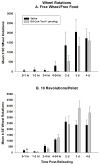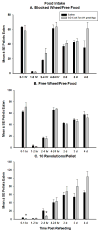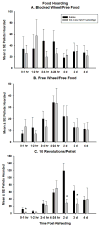Inhibition of ghrelin O-acyltransferase attenuates food deprivation-induced increases in ingestive behavior
- PMID: 23399323
- PMCID: PMC3633643
- DOI: 10.1016/j.yhbeh.2013.02.001
Inhibition of ghrelin O-acyltransferase attenuates food deprivation-induced increases in ingestive behavior
Abstract
Ghrelin is an orexigenic hormone produced by the stomach in direct proportion to the time since the last meal and has therefore been called a 'hunger signal'. The octanoylation of ghrelin is critical for its orexigenic functions and is dependent upon ghrelin O-acyltransferase (GOAT) catalyzation. The GOAT inhibitor, GO-CoA-Tat, decreases the circulating concentrations of octanoylated ghrelin and attenuates weight gain on a high fat diet in mice. Unlike rats and mice, Siberian hamsters and humans do not increase food intake after food deprivation, but increase food hoarding after food deprivation. In Siberian hamsters, exogenous ghrelin increases ingestive behaviors similarly to 48-56 h food deprivation. Therefore, we tested the necessity of increased ghrelin in food-deprived Siberian hamsters to stimulate ingestive behaviors. To do so we used our simulated natural housing system that allows hamsters to forage for and hoard food. Animals were given an injection of GO-CoA-Tat (i.p., 11 μmol/kg) every 6h because that is the duration of its effective inhibition of octanoylated ghrelin concentrations during a 48 h food deprivation. We found that GO-CoA-Tat attenuated food foraging (0-1h), food intake (0-1 and 2-4h), and food hoarding (0-1h and 2 and 3 days) post-refeeding compared with saline treated animals. This suggests that increased octanoylated ghrelin concentrations play a role in the food deprivation-induced increases in ingestive behavior. Therefore, ghrelin is a critical aspect of the multi-faceted mechanisms that stimulate ingestive behaviors, and might be a critical point for a successful clinical intervention scheme in humans.
Copyright © 2013 Elsevier Inc. All rights reserved.
Figures




Similar articles
-
Anti-ghrelin Spiegelmer inhibits exogenous ghrelin-induced increases in food intake, hoarding, and neural activation, but not food deprivation-induced increases.Am J Physiol Regul Integr Comp Physiol. 2013 Aug 15;305(4):R323-33. doi: 10.1152/ajpregu.00097.2013. Epub 2013 Jun 26. Am J Physiol Regul Integr Comp Physiol. 2013. PMID: 23804279 Free PMC article.
-
AgRP knockdown blocks long-term appetitive, but not consummatory, feeding behaviors in Siberian hamsters.Physiol Behav. 2018 Jun 1;190:61-70. doi: 10.1016/j.physbeh.2017.10.008. Epub 2017 Oct 12. Physiol Behav. 2018. PMID: 29031552 Free PMC article.
-
Peripheral ghrelin injections stimulate food intake, foraging, and food hoarding in Siberian hamsters.Am J Physiol Regul Integr Comp Physiol. 2005 Mar;288(3):R716-22. doi: 10.1152/ajpregu.00705.2004. Epub 2004 Dec 2. Am J Physiol Regul Integr Comp Physiol. 2005. PMID: 15576659
-
Ghrelin O-acyltransferase (GOAT) and energy metabolism.Sci China Life Sci. 2016 Mar;59(3):281-91. doi: 10.1007/s11427-015-4973-6. Epub 2016 Jan 6. Sci China Life Sci. 2016. PMID: 26732975 Review.
-
Neural and hormonal control of food hoarding.Am J Physiol Regul Integr Comp Physiol. 2011 Sep;301(3):R641-55. doi: 10.1152/ajpregu.00137.2011. Epub 2011 Jun 8. Am J Physiol Regul Integr Comp Physiol. 2011. PMID: 21653877 Free PMC article. Review.
Cited by
-
Molecular Mechanisms and Health Benefits of Ghrelin: A Narrative Review.Nutrients. 2022 Oct 8;14(19):4191. doi: 10.3390/nu14194191. Nutrients. 2022. PMID: 36235843 Free PMC article. Review.
-
Neuroendocrine regulation of appetitive ingestive behavior.Front Neurosci. 2013 Nov 15;7:213. doi: 10.3389/fnins.2013.00213. Front Neurosci. 2013. PMID: 24298235 Free PMC article. Review.
-
Central ghrelin increases food foraging/hoarding that is blocked by GHSR antagonism and attenuates hypothalamic paraventricular nucleus neuronal activation.Am J Physiol Regul Integr Comp Physiol. 2016 Feb 1;310(3):R275-85. doi: 10.1152/ajpregu.00216.2015. Epub 2015 Nov 11. Am J Physiol Regul Integr Comp Physiol. 2016. PMID: 26561646 Free PMC article.
-
Differential gene regulation of GHSR signaling pathway in the arcuate nucleus and NPY neurons by fasting, diet-induced obesity, and 17β-estradiol.Mol Cell Endocrinol. 2016 Feb 15;422:42-56. doi: 10.1016/j.mce.2015.11.007. Epub 2015 Nov 11. Mol Cell Endocrinol. 2016. PMID: 26577678 Free PMC article.
-
Control of Food Intake by Gastrointestinal Peptides: Mechanisms of Action and Possible Modulation in the Treatment of Obesity.J Neurogastroenterol Motil. 2017 Apr 30;23(2):180-196. doi: 10.5056/jnm16194. J Neurogastroenterol Motil. 2017. PMID: 28096522 Free PMC article. Review.
References
-
- Abizaid A, Liu ZW, Andrews ZB, Shanabrough M, Borok E, Elsworth JD, Roth RH, Sleeman MW, Picciotto MR, Tschop MH, Gao XB, Horvath TL. Ghrelin modulates the activity and synaptic input organization of midbrain dopamine neurons while promoting appetite. J Clin Invest. 2006;116:3229–3239. - PMC - PubMed
-
- Ariyasu H, Takaya K, Tagami T, Ogawa Y, Hosoda K, Akamizu T, Suda M, Koh T, Natsui K, Toyooka S, Shirakami G, Usui T, Shimatsu A, Doi K, Hosoda H, Kojima M, Kangawa K, Nakao K. Stomach is a major source of circulating ghrelin, and feeding state determines plasma ghrelin-like immunoreactivity levels in humans. J Clin Endocrinol Metab. 2001;86:4753–4758. - PubMed
-
- Barnett BP, Hwang Y, Taylor MS, Kirchner H, Pfluger PT, Bernard V, Lin YY, Bowers EM, Mukherjee C, Song WJ, Longo PA, Leahy DJ, Hussain MA, Tschop MH, Boeke JD, Cole PA. Glucose and weight control in mice with a designed ghrelin O-acyltransferase inhibitor. Science. 2010;330:1689–1692. - PMC - PubMed
Publication types
MeSH terms
Substances
Grants and funding
LinkOut - more resources
Full Text Sources
Other Literature Sources

